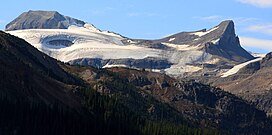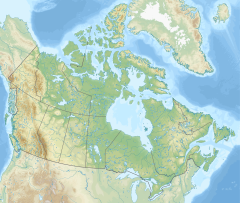Mount Olive (Canadian Rockies)
| Mount Olive | |
|---|---|
 Mount Olive (left) with Saint Nicholas Peak (right) seen from Bow Lake | |
| Highest point | |
| Elevation | 3,126 m (10,256 ft)[1] |
| Prominence | 146 m (479 ft)[2] |
| Listing | |
| Coordinates | 51°36′40″N 116°29′30″W / 51.61111°N 116.49167°W[3] |
| Geography | |
| Country | Canada |
| Provinces | Alberta and British Columbia |
| Protected areas | |
| Parent range | Park Ranges Canadian Rockies |
| Topo map | NTS 82N9 Hector Lake[3] |
| Climbing | |
| First ascent | 1927 M. Cropley, F.A. Gambs, N.L. Goodrich, L. Grassi[1][2] |
Mount Olive is located N of the head of the Yoho River on the Continental Divide, on the Alberta-British Columbia border, in both Banff National Park and Yoho National Park.[4] It lies on the eastern edge of the Wapta Icefield, and is part of the Waputik Mountains. It was named in 1898 by H.B. Dixon after his wife Dixon, Olive.[1][2][4]
Geology
[edit]The peak is composed of sedimentary rock laid down during the Precambrian to Jurassic periods.[5] Formed in shallow seas, this sedimentary rock was pushed east and over the top of younger rock during the Laramide orogeny.[6]
Climate
[edit]Based on the Köppen climate classification, it is located in a subarctic climate with cold, snowy winters, and mild summers.[7] Temperatures can drop below -20 °C with wind chill factors below -30 °C.
See also
[edit]Further reading
[edit]- Birrell, Dave (2000). 50 Roadside Panoramas in the Canadian Rockies. Rocky Mountain Books. p. 51. ISBN 978-0-921102-65-6. Retrieved 2021-07-11.
References
[edit]- ^ a b c "Mount Olive". cdnrockiesdatabases.ca. Retrieved 2019-06-07.
- ^ a b c "Mount Olive". Bivouac.com. Retrieved 2019-06-07.
- ^ a b "Mount Olive (Alberta)". Geographical Names Data Base. Natural Resources Canada. Retrieved 2023-10-14.
- ^ a b "Mount Olive". BC Geographical Names. Retrieved 2023-10-14.
- ^ Belyea, Helen R. (1960). The Story of the Mountains in Banff National Park (PDF). parkscanadahistory.com (Report). Ottawa: Geological Survey of Canada. Archived (PDF) from the original on 2015-10-02. Retrieved 2019-09-13.
- ^ Gadd, Ben (2008). Geology of the Rocky Mountains and Columbias.
- ^ Peel, M. C.; Finlayson, B. L.; McMahon, T. A. (2007). "Updated world map of the Köppen−Geiger climate classification". Hydrol. Earth Syst. Sci. 11 (5): 1633–1644. Bibcode:2007HESS...11.1633P. doi:10.5194/hess-11-1633-2007. ISSN 1027-5606.



